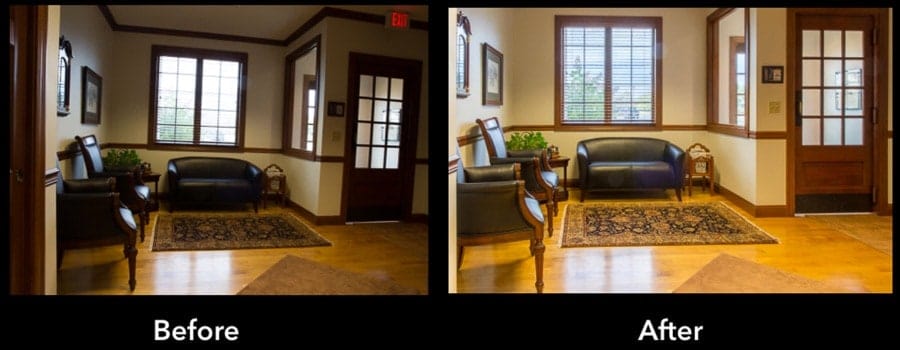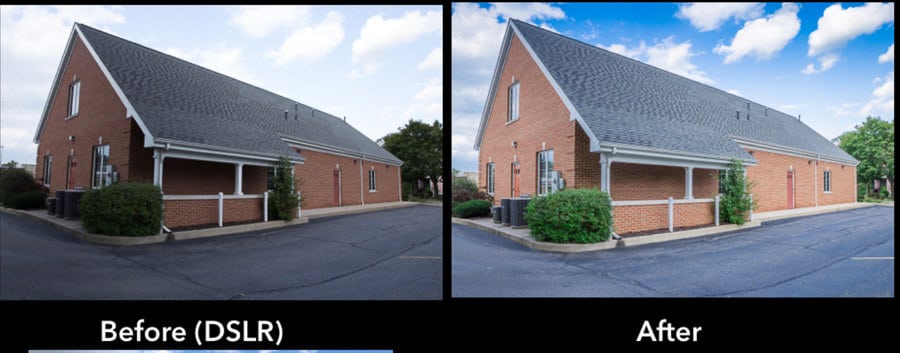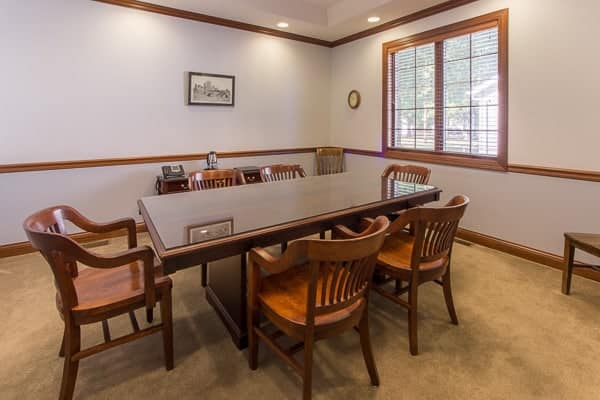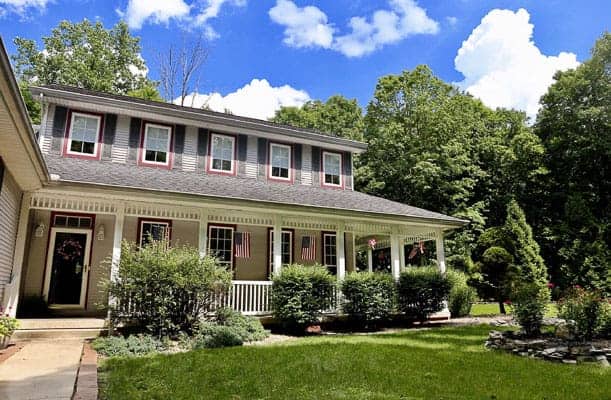
Not every idea belongs in your marketing plan. Maybe realtors and sellers in your area are more interested in fast turn-around than magazine-quality photo spreads. Maybe they want you to work directly with sellers. Get to know the residential and commercial properties in your area before you design and price photography packages.
But before you jump into real estate photography head first, head over to improve photography's real estate starter pack if you haven't already. The Lightroom presents alone are worth that small investment. Once you've learned and practiced your technique, consider some of these ideas to have you breaking into the real estate photography market in no time.
 1. Make the first photo shoot free.
1. Make the first photo shoot free.
Seeing is believing. While a real estate agent or a home seller might understand in the abstract that his or her house listing could be improved by better photos, many assume that the cost is not worth the investment in professional photography services. Or they think that it will take too long to get photos posted to their listing. Whatever the reason for their hesitancy, offering them a free shoot is the fastest way to get them to the crossroads.
What's at the crossroads? The moment that the real estate agent or property owner compares her existing, ordinary photos to your images. At the crossroads, the real estate photography client hears a voice in her head that says “Sharon, all your listing pictures could look this good.” That is, assuming her name is Sharon. If it's not, then that would be weird and you're not responsible for those voices in her head.

To be clear, the “first shoot free” idea is not the same as providing photography work for the “exposure.” Shooting a free sample gets your work in front of your market of future customers. Shooting for exposure waters down that target to the general public. The former is a targeted marketing effort, the later is broad, attenuated, and typically ineffective.

There's one more reason to steer away from just shooting for “exposure,” that has to do with the difference between price and value. Unlike Sharon the real estate agent, who knows from the get-go that your free work is a one-time event being used as part of a larger marketing effort, your friend Betty the bride is in a different position. You've given Betty the whole value of a wedding photographer if you photograph her nuptials in exchange for the promise of exposure. Betty will have no further need for your services (absent divorces or, well, bigamy). Whatever she tells her friends about the quality of your work, its value to Betty is already fixed at zero. Sharon, however, potentially needs real estate photos many, many more times. If she believes your free images were of high quality, and she knows she'll have to pay for future ones–then the value to Sharon is not fixed with the first photos.
Betty might think your wedding photos are very good–even great. But she's unlikely to think the wedding pics are valuable no matter how good they are, since she gave little value in return. You don't want Betty to tell her friends the photos are good, you want her to tell friends that the images and service were worth the price. How can she know that if she paid nothing? Good word of mouth marketing tells potential customers the work is valuable (i.e., worth the price).

2. Cater a lunch for a small office of real estate agents and give a short presentation.
Just like the “first shoot free” technique, this is an opportunity to get the real estate agents to the crossroads–comparing quality real estate photos with mediocre ones. Cater an affordable lunch to a handful of real estate agents in a local office. Use the opportunity for a slide show or print examples of your professional photos compared to images taken from smartphones with no post-processing or with bad lighting. I cannot stress enough how important it is for the agents to see the contrast for themselves through the light of your quality photos.
You don't have to be derisive or critical of their listing photos–let them reach their own conclusions. A luxury car salesman doesn't need to tell me that my 1984 Oldsmobile Firenza is a piece of rusty metal and pleather held together with duct tape and Hubba Bubba. I know. Believe me, I know. He lets me come to that conclusion on my own.
Keep it casual and informational. Ask about their typical real estate client and typical listing. What do they want most from a photographer? Put yourself in their shoes. Don't just talk about exposure and dynamic range. The better you understand their workflow, the better you can customize your service to meet their needs.
 3. Offer free smartphone photo tips in exchange for a presentation about your paid work.
3. Offer free smartphone photo tips in exchange for a presentation about your paid work.
This technique might also seem counter-intuitive or illogical at first. Isn't the whole idea of marketing your real estate photos to get real estate agents to move away from taking smartphone photos and hire you?
Not exactly. The goal is to get them to hire you as often as possible for the highest professional fee possible. How many listings they don't hire you for doesn't matter. Most real estate agents have some listings they will never hire a professional photographer for, no matter how good you are. Maybe they have some listings that are unimproved property, such as a vacant lot or agricultural property. Maybe they have some real fixer-uppers that are on the low-end of the market, and they're just not going to invest in professional images.
Don't pretend that these listings don't exist. Instead, take the opportunity to show your expertise. Give them 20 minutes on lighting and composition. Show them the benefits of shooting in their smartphone's HDR mode. They will remember that you made these throw-away listings a little bit better. And when it's time for bigger listings and an investment into better photos, they'll remember that, too.
4. Offer your highest package for the price of the lowest package for first-time clients.
Like the “first shoot free” technique, this gives them a reason to see what your services are all about. It also gets your best work in front of them. It may be that your premium photos feature composite techniques with multiple light sources, blue hour photos, or drone work. Whatever your high end work product delivers, this allows them to remember you for this, while still generating some revenue for you.
Economists often talk about prices as being a signal of quality. By charging something greater than zero, and yet providing your best work, you're sending two messages simultaneously: (1) your high quality work is worth an increased professional fee; and (2) even your basic package worth a modest fee.

5. Photograph your own house to build up a portfolio
You have to start somewhere. At your own house, you can make sure to prepare important “before and after” photos that contrast ordinary with more polished images.
It will also allow you to take your time, a luxury that you may not always have when being on location in someone else's home. I recommend practicing with the same gear that you would take into a real estate location, no more and no less.
6. Go to open houses and meet real estate agents.
Networking is important in any business. Real estate agents work in an environment that is transaction-based–particularly with residential real estate. They sign a listing, court a buyer, have a closing and move on. While they may certainly have repeat clients, each is for a new listing. Contrast this with your dentist, with whom you have a continuous professional relationship over many years. A real estate agent is probably even more dependent on networking than a photographer, since their professional service is truly intangible.
If you go to an open house, first look at the listing's photos. Could they be improved through better technique or variety? Or are they already top-notch but the realtor probably paid too much for them? For example, suppose it's an older home without an open floor plan. You might say, “Those restored kitchen cabinets are beautiful, have you considered using a wider angle in the photos in your listing?”
Open houses are designed to showcase a particular property for prospective buyers, and a realtor is expecting to network at these events, but be courteous and conscious of the realtor's time. No realtor wants to be tied up talking to a photographer on the make while the house's perfect buyer glides in and out of the front parlor without being greeted. Don't try to monopolize the agent's attention.
7. Look for high-end listings online with bad photos.
If you see a property that looks like it could be improved, use its online imagery as a starting point. Do the exteriors lack an attractive sky? Do the interiors look too dark or washed out by window light? Could HDR or composite lighting techniques improve the information conveyed to the viewer?
Remember that the MLS, or Multiple Listing Service, is less a single website with listings, and more of a technique for realtors to share information about listings. This sharing is, first and foremost, a way to share fees for shared work. The National Association of Realtors reports that the idea of listing services–where realtors met in local associations to share details and encourage cooperation and agreed to compensate other brokers–dates back to the 1800s.
Why should photographers care how the MLS works? Because real estate brokers might not have an equal affinity for improving every listing. If Abigail lists property A and Barry lists property B, a prospective buyer can probably work with either Abigail or Barry to see property A, but Abigail has a greater incentive to make sure that its listing attracts a buyer. So, start with the MLS, then drill down to the listing agent–not merely any realtor who will arrange to discuss the property with you–before making a pitch for photography services.
8. Offer a “post-processing only” package a service.
I've had realtors tell me that the two most pressing concerns that keep them from hiring photographers are cost and time. Cost is understandable and tangible. But time is also a critical component of a real estate agent's profitability. The sooner photos are on the listing website, the sooner the listing will attract possible buyers. In a fast market, a photographer who can't get to the property for two weeks might be more costly to the listing than mediocre photographs.
Voltaire is credited with saying, “Perfect is the enemy of good.” That can be true in the symbiosis between photographers and realtors as well. Photographers want good weather, good lighting, a home that is clean from clutter, and plenty of time to set up their lighting just right. Realtors would love magazine-quality photo spreads for every listing, but not all properties warrant the required fee for that production. Both parties often settle on the bargain of good photos quickly and at a reasonable price.
One way to bridge this gap may be to offer a “post-processing only” package to the real estate agent. To do this effectively, it would certainly help to make sure that the agent has some basic composition training. With the technology available now, its even possible for a real estate agent to take RAW photos with an entry-level DSLR or mirror-less camera and forward to you for post-processing.
As photographers, our hesitancy to this technique lies in giving up the control that comes with using our own equipment. (Not to mention how much money we've spent on our equipment!). But don't overlook the benefit to your client. An agent has already been to the property once or twice and taken one set of pictures. She has had the listing online for a while by the time you wander to the listing online and say, “Hey, how'd you like me to take better photos of that house for you?” In essence, you're asking the realtor to back up the truck: arranging for you to take photos anew, then getting those images from you in the future and updating the listing.
All of this takes time. As every real estate contract you've ever signed says: Time is of the essence. That's not just true of the buyer and seller. It's true for the realtor. And if that's your client, it needs to be true for the photographer as well. By adapting your services to understand and respond to the pressures faced by real estate agents, you present your services as meeting an acute business need, not merely as a value-added service.
Conclusion
Understanding the way that real estate agents and sellers use quality photography services is key to marketing your business. Real estate agents are extremely busy, and anything you can do to present your “elevator speech,” or your portfolio to them in a simple and logical manner is a key step to getting your foot in the door. Don't be afraid to offer some thing for free–a free upgrade, a free first shoot, or sharing your knowledge about what improves real estate photos–so long as it helps them see the value of the good work that you do.

 1. Make the first photo shoot free.
1. Make the first photo shoot free. 3. Offer free smartphone photo tips in exchange for a presentation about your paid work.
3. Offer free smartphone photo tips in exchange for a presentation about your paid work.
Thank you so much for the great ideas! I recently started shooting Real Estate and really appreciate the marketing tips.
Glad you enjoyed it, and thanks for reading!
Good information shared. Thanks
Andy, thank you very much for the info provided. It can be a helpful guide for those who deal with real estate photography. Free catering is a marvelous idea, absolutely.
Another great item is concerning smartphone tips, as they are the commonly used tech nowadays, so such pieces of advice will be of interest for the majority of the target audience.
Moreover, free issues can always work for your success.
Hi Andy,
I found your comments very informative.
Thanks for imparting all this knowledge mate.
Have a great day.
Helpful. What do you chose to do when you offer 3 different agents with different groups, that one pro-bono shoot, drone and all, they use the work then avoid you? At what point do you put the brakes on in smaller markets (like pop of 300,000 not counting burbs)?
This is amazing, thank you for sharing this one. I should take note of this.
THANK YOU! Great info! I am trying to do a little more real estate photography! Loved this article!